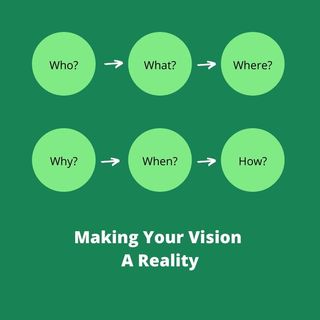Dreaming
Make Your Vision a Reality
It's time to create the future you've been dreaming about.
Posted December 18, 2019 Reviewed by Ekua Hagan

In my previous blog post, "Create a Compelling Future," I focused on the importance of finding time to envision your new future. Creating a compelling vision is the first step in changing any aspect of your life, including your career.
If you haven’t had a chance to develop your vision, I recommend you stop reading this post and go to the previous one. But if you have your vision, then let’s look at the steps to bring it to fruition.
You can do this in four steps. I wish I could tell you these four steps are simple or easy, but they’re not. Each of these steps will require your time and attention. You can't phone it in—you will have to do the work. But that doesn't mean the process has to be hard. In fact, because you are reaching toward something you want, it will hopefully be more interesting and pleasurable for you.
Let’s take a look at these four basic steps to turn your vision into reality. Here's a diagram to help you think through the questions being asked in each of the four steps.
Step 1: Vision. Start with the vision you created. How concrete is it? Is it just an idea, or can you actually see the components of the vision? If you haven’t already, take the time to write out your vision for your future. What do you want your life to look like? One way to do this is to start with the three questions every investigator asks: Who, What, and Where?
As you think about the vision you developed, who is a part of that vision? Will they be your clients or customers? Or perhaps the “who” is who you will work with, your colleagues. Another “who” in your vision might be your family or friends. How are they part of your vision? And “who” can help you succeed with this vision? Are there experts you need to consult to make sure your vision can happen? Who are the people you need to have around you to make this vision succeed?
What are you doing? What activities are you engaged in? What is happening in the area where you are working or living? Are you working with people, data, things, or ideas? And in what way? Write out a typical day in your new life. What is happening?
And where is all this happening? Are you in your current location, at your current workplace? Or are you in a new location? Are you working from home? And where is your home? Describe your surroundings if you haven’t done that already.
Once you have answered these questions as well as you can, you can move to the next step.
Step 2: Decision. Now it’s time to make some decisions. You have this lovely vision for your future. You know who is involved, what you’re doing, and where you’re going to be. So stop for a moment. Notice how you feel. Is your vision exciting you? Is it something you genuinely want to move toward? Here’s where the fourth investigator’s question comes in handy: Why? What is compelling about your vision? Why do you want to do it? What will change as a result of this new vision? How is this vision connected to your thoughts about purpose or meaning in your life?
Once you have your “why,” it’s time to move into making it happen.
Step 3: Intention. This step moves you to the investigator’s fifth question: How? What are the steps needed to make this happen? Start by writing down every action you might need to take to bring this reality to life. Depending on how large a change you’re making, this could be a daunting task. But if you don’t break down the steps into achievable units, you are less likely to succeed. After you write down the steps you need to take to make this vision happen, try ordering them from first to last. You might want to use an app like Trello to organize your steps and set up a timeline.
Which brings us to the final stage and the investigator’s sixth question: When?
Step 4: Action. And now the final investigator's question. When do you want to move forward? Your success will be directly related to taking action. However, this doesn’t mean you have to do it all yourself.
- Sometimes just taking the first few steps will connect you with someone who might be able to help you.
- Or you take a few steps and discover a job posting for the very job you want.
- Or you see the perfect apartment in the city you’d like to move to.
Just starting to move forward in your vision process is often enough to start a chain of events that helps you get to your final goal. That's why putting a time stamp on the steps to your vision will make it more likely that you'll achieve it. Momentum can take over and you may be surprised at what comes forward when you just start.
If you’re not taking action, then it’s time to re-assess your situation. We often procrastinate around the things that are most important to us. That might be what you’re doing. If that's the case, you might need outside support to stay motivated and focused.
Or maybe you’re not taking action because you’ve looked at everything more closely and changed your mind. It’s no longer your vision. That’s a great thing to learn before you get too far in the process. Now you can adjust your vision as necessary based on what you have learned in the process.
Your vision will change throughout your life. It is likely that you will land in the vision of your future, only to have a new vision take over. That’s how it works. Now you know how to start the process all over again if needed.
© 2019 Katharine S. Brooks, All Rights Reserved.




